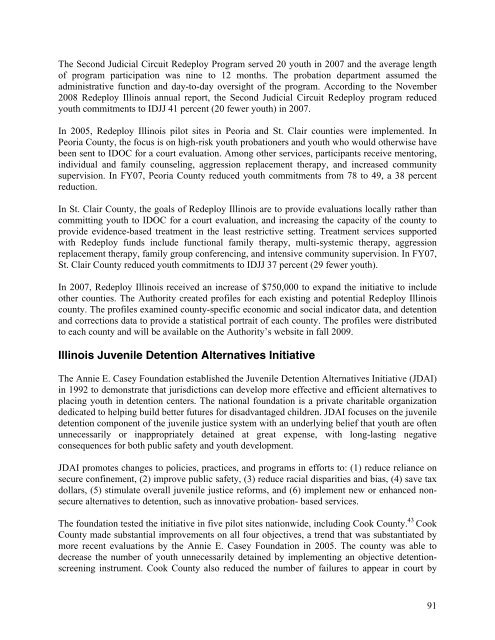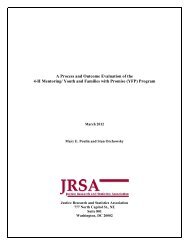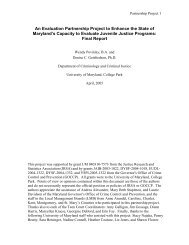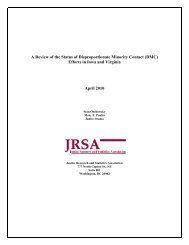Juvenile Justice System and Risk Factor Data - Illinois Criminal ...
Juvenile Justice System and Risk Factor Data - Illinois Criminal ...
Juvenile Justice System and Risk Factor Data - Illinois Criminal ...
Create successful ePaper yourself
Turn your PDF publications into a flip-book with our unique Google optimized e-Paper software.
The Second Judicial Circuit Redeploy Program served 20 youth in 2007 <strong>and</strong> the average length<br />
of program participation was nine to 12 months. The probation department assumed the<br />
administrative function <strong>and</strong> day-to-day oversight of the program. According to the November<br />
2008 Redeploy <strong>Illinois</strong> annual report, the Second Judicial Circuit Redeploy program reduced<br />
youth commitments to IDJJ 41 percent (20 fewer youth) in 2007.<br />
In 2005, Redeploy <strong>Illinois</strong> pilot sites in Peoria <strong>and</strong> St. Clair counties were implemented. In<br />
Peoria County, the focus is on high-risk youth probationers <strong>and</strong> youth who would otherwise have<br />
been sent to IDOC for a court evaluation. Among other services, participants receive mentoring,<br />
individual <strong>and</strong> family counseling, aggression replacement therapy, <strong>and</strong> increased community<br />
supervision. In FY07, Peoria County reduced youth commitments from 78 to 49, a 38 percent<br />
reduction.<br />
In St. Clair County, the goals of Redeploy <strong>Illinois</strong> are to provide evaluations locally rather than<br />
committing youth to IDOC for a court evaluation, <strong>and</strong> increasing the capacity of the county to<br />
provide evidence-based treatment in the least restrictive setting. Treatment services supported<br />
with Redeploy funds include functional family therapy, multi-systemic therapy, aggression<br />
replacement therapy, family group conferencing, <strong>and</strong> intensive community supervision. In FY07,<br />
St. Clair County reduced youth commitments to IDJJ 37 percent (29 fewer youth).<br />
In 2007, Redeploy <strong>Illinois</strong> received an increase of $750,000 to exp<strong>and</strong> the initiative to include<br />
other counties. The Authority created profiles for each existing <strong>and</strong> potential Redeploy <strong>Illinois</strong><br />
county. The profiles examined county-specific economic <strong>and</strong> social indicator data, <strong>and</strong> detention<br />
<strong>and</strong> corrections data to provide a statistical portrait of each county. The profiles were distributed<br />
to each county <strong>and</strong> will be available on the Authority’s website in fall 2009.<br />
<strong>Illinois</strong> <strong>Juvenile</strong> Detention Alternatives Initiative<br />
The Annie E. Casey Foundation established the <strong>Juvenile</strong> Detention Alternatives Initiative (JDAI)<br />
in 1992 to demonstrate that jurisdictions can develop more effective <strong>and</strong> efficient alternatives to<br />
placing youth in detention centers. The national foundation is a private charitable organization<br />
dedicated to helping build better futures for disadvantaged children. JDAI focuses on the juvenile<br />
detention component of the juvenile justice system with an underlying belief that youth are often<br />
unnecessarily or inappropriately detained at great expense, with long-lasting negative<br />
consequences for both public safety <strong>and</strong> youth development.<br />
JDAI promotes changes to policies, practices, <strong>and</strong> programs in efforts to: (1) reduce reliance on<br />
secure confinement, (2) improve public safety, (3) reduce racial disparities <strong>and</strong> bias, (4) save tax<br />
dollars, (5) stimulate overall juvenile justice reforms, <strong>and</strong> (6) implement new or enhanced nonsecure<br />
alternatives to detention, such as innovative probation- based services.<br />
The foundation tested the initiative in five pilot sites nationwide, including Cook County. 43 Cook<br />
County made substantial improvements on all four objectives, a trend that was substantiated by<br />
more recent evaluations by the Annie E. Casey Foundation in 2005. The county was able to<br />
decrease the number of youth unnecessarily detained by implementing an objective detentionscreening<br />
instrument. Cook County also reduced the number of failures to appear in court by<br />
91

















